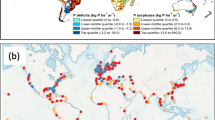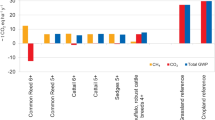Abstract
Understanding the dynamics of society’s physical exchange processes with the environment (society’s metabolism) is a major theme of long-term socioecological research. In this paper, we adapt the concept of socioecological metabolism to analyze the competition between gunpowder production and agriculture for nitrogen (N) in the pre-industrial agro-ecosystem of Pamhagen in the late eighteenth century. Saltpeter (KNO3)—the main ingredient of gunpowder—was chemically refined from agricultural waste products, in particular manure and wood ash, which were vital for the maintenance of soil fertility. In this paper, we reconstruct nitrogen flows in the agro-ecosystem of Pamhagen and establish a nutrient balance, which allows assessing the impact of saltpeter production on agricultural soil fertility management. We find that nitrate extracted by saltpeter production in our case study was equivalent to 23 % of the total available nitrogen in manure in 1778 and 12 % in 1780. The growing demand for gunpowder and thus the artisanal production of saltpeter became influential drivers in the management of societal nitrogen flows on the local level, competing over key resources for sustaining soil fertility and leaving a substantial imprint on the nutrient budget of agricultural soils as less nitrogen was available for plant uptake.

Similar content being viewed by others
References
Ágoston G (2008) Behind the Turkish war machine: gunpowder technology and war industry in the Ottoman Empire, 1450–1700. In: Steele BD, Dorland T (eds) The heirs of archimedes: science and the art of war through the age of enlightenment. MIT Press, Cambridge, pp 101–133
Allen RC (2008) The nitrogen hypothesis and the english agricultural revolution: a biological analysis. J Econ Hist 68:182–210. doi:10.1017/S0022050708000065
Barnum DW (2003) Some history of nitrates. J Chem Educ 80:1393–1396. doi:10.1021/ed080p1393
Bartosiewicz L (1997) The Hungarian grey cattle: a traditional European breed. Anim Genet Resour Inf 21:49–60. doi:10.1017/S1014233900000924
Beck R (1993) Unterfinning: ländliche Welt vor Anbruch der Moderne. C H Beck, München
Benecke N (1994) Der Mensch und seine Haustiere. Die Geschichte einer jahrtausendealten Beziehung, Stuttgart
Berzeviczy G (1816) Ueber den Zustand der Bauern in Ungarn. Europäische Annalen 11:159–207
Buchanan BJ (2006) Gunpowder, explosives and the state: a technological history. Ashgate, Aldershot
Bundesministerium für Land- und Forstwirtschaft (1991) Wirtschaftsdünger. Richtige Gewinnung und Anwendung, tiergerecht, wirksam, wirtschaftlich, qualitätsbewusst, bodenschonend, umweltfreundlich. Bundesministerium für Land- und Forstwirtschaft, Wien
Cepuder P (2004) Landwirtschaft und Lysimeter. LFZ Raumberg-Gumpenstein Publishing. http://www.raumberg-gumpenstein.at/cm4/de/forschung/publikationen/downloadsveranstaltungen/viewdownload/122-grundwasserseminar/12169-lysimeter-und-landwirtschaft.html. Accessed November 15 2014
Chorley GPH (1981) The agricultural revolution in northern Europe, 1750–1880: nitrogen, legumes, and crop productivity. Econ Hist Rev 34:71–93. doi:10.1111/j.1468-0289.1981.tb02007.x
Cottrill BR, Smith KA (2007) Nitrates consultation supporting paper F2: nitrogen output of livestock excreta. Final report, Defra Project WT0715NVZ, ADAS
Cressy D (2013) Saltpeter: mother of Gunpowder. Oxford University Press, Oxford
Cunfer G (2004) Manure matters on the Great Plains frontier. J Interdiscip Hist 34:539–567. doi:10.1162/002219504773512534
Cussó X, Garrabou R, Tello E (2006) Social metabolism in an agrarian region of Catalonia (Spain) in 1860–1870: flows, energy balance and land use. Ecol Econ 58(1):49–65. doi:10.1016/j.ecolecon.2005.05.026
Dezseoe D, Zoltan D (1960) Az elsö Magyarorszagi népszámlálás (1784–1787). Müvelödesügyi Minisztérium Leveltari Osztalya, Budapest
Donahue B (2004) The great meadow: farmers and the land in colonial Concord. Yale University Press, New Haven
Dong H, Mangino J, McAllister TA et al (2006) Emissions from livestock and manure management. In: Intergovernmental Panel on Climate Change (ed) 2006 IPCC guidelines for national greenhouse gas inventories, vol 4. Institute for Global Environmental Strategies (IGES), Hayama, pp 10.1–10.87
Elliott LF, McCalla TM, Mielke LN, Travis TA (1972) Ammonium, nitrate, and total nitrogen in the soil water of feedlot and field soil profiles. Appl Microbiol 23(4):810–813
Fally J (2010) Naturjuwele im Burgenland: Steppen, Salz und Streuobstwiesen. Amt der Burgenländischen Landesregierung, Eisenstadt
Fischer-Kowalski M, Haberl H (2007) Socioecological transitions and global change: trajectories of social metabolism and land use. Edward Elgar, Cheltenham
Franck J (2000) Der Neusiedler Saliterhof. In: Neusiedler Jahrbuch: Beiträge zur Stadtgeschichte von Neusiedl am See 2:19–34
Frey JW (2009) The Indian saltpeter trade, the military revolution, and the rise of Britain as a global superpower. Historian 71:507–554. doi:10.1111/j.1540-6563.2009.00244.x
Galler J (2009) Wirtschaftsdünger. Kreislauf - Düngung - Umwelt. Landwirtschaftskammer Salzburg, Salzburg
García-Ruiz R, González de Molina M, Guzmán G et al (2012) Guidelines for constructing nitrogen, phosphorus, and potassium balances in historical agricultural systems. J Sustain Agric 36(6):650–682. doi:10.1080/10440046.2011.648309
Good D (1984) The economic rise of the Habsburg empire, 1750–1914. University of California Press, London
Götz B, Zethner G (1996) Regionale Stoffbilanzen in der Landwirtschaft. Der Nährstoffhaushalt im Hinblick auf seine Umweltwirkung am Beispiel des Einzugsgebietes Strem. Bundesministerium für Umwelt, Jugend und Familie, Wien
Grailich A (1821) Wieselburger Gespanschaft. In: Csaplovics J (ed) Topographisch-statistisches Archiv des Königreichs Ungern 2. Anton Doll, Wien, pp 187–236
Grosina H (1984) Aspekte des Beziehungsgefüge Mensch - Raum am Neusiedler See. In: Landesarchiv Burgenländisches (ed) Burgenland in seiner pannonischen Umwelt, Sonderband Burgenländische Forschungen 7. Landesarchiv Burgenland, Eisenstadt, pp 117–125
Guzmán Casado GI, González de Molina M (2009) Preindustrial agriculture versus organic agriculture. Land Use Policy 26:502–510. doi:10.1016/j.landusepol.2008.07.004
Guzmán GI, González de Molina M, Alonso AM (2011) The land cost of agrarian sustainability. An assessment. Land Use Policy 28:825–835. doi:10.1016/j.landusepol.2011.01.010
Haberl H, Erb K-H, Gaube V et al (2013) Socioeconomic metabolism and the human appropriation of net primary production: what promises do they hold for LTSER? In: Singh SJ, Haberl H, Chertow M et al (eds) Long term socio-ecological research across spatial and temporal scales. Springer, Dodrecht, pp 29–52
Häusler H, Heischmann J (2009) Quartäre Landschaftsentwicklung und Morphotektonik des nördlichen Burgenlandes. In: Hitz H, Wohlschlägl H (eds) Das östliche Österreich und benachbarte Regionen. Ein geographischer Exkursionsführer. Böhlau, Wien, Köln, Weimar, pp 117–132
Hitschmann HH (1891) Vademecum für den Landwirth. M. Perles, Wien
Hoffman PC (2007) Innovations in dairy replacement heifer management. In: Proceedings of the 8th Western Dairy Management Conference, Reno, pp 237–248
Holland EA, Dentener FJ, Braswell BH, Sulzman JM (1999) Contemporary and pre-industrial global reactive nitrogen budgets. In: Townsed AR (ed) New perspectives on nitrogen cycling in the temperate and tropical Americas: report of the international SCOPE nitrogen project. Springer, Dodrecht, pp 7–43
Janovick NA, Russell JR, Strohbehn DR, Morrical DG (2004) Productivity and hay requirements of beef cattle in a Midwestern year-round grazing system. J Anim Sci 82:2503–2515
Konrad A (2005) Wetter und Klima im Burgenland. Wetterchronik, Klimatabellen, Wettervorhersagen, offizielle Wetterdienste, burgenländische Wetterstation im Portrait. Eigenverl. A. Konrad, Salmannsdorf
Kornhuber A (1885) Botanische Ausflüge in die Sumpfniederungen des „Wasen“(magyr. “Hanság”). Verh Zoo-Bot Ges Wien 35:619–656
Krausmann F (2004) Milk, manure, and muscle power. Livestock and the transformation of preindustrial agriculture in Central Europe. Hum Ecol 32:735–772. doi:10.1007/s10745-004-6834-y
Krausmann F (2008) Land use and socio-economic metabolism in pre-industrial agricultural systems: four nineteenth-century Austrian villages in comparison. Soc Ecol Work Paper 72:1–45
Kriedtke P (1980) Spätfeudalismus und Handelskapital. Grundlinie der europäischen Wirtschaftsgeschichte vom 16. bis zum Ausgang des 18. Jahrhunderts. Vandenhoeck & Ruprecht, Göttingen
Kunnas J (2007) Potash saltpeter and tar: production, exports and use of wood in Finland in the 19th century. Scand J Econ 32:281–311. doi:10.1080/03468750701395419
Leigh GJ (2004) The world’s greatest fix: a history of nitrogen and agriculture. Oxford University Press, Oxford
Loomis RS, Connor DJ (2003) Crop ecology: productivity and management in agricultural systems. Cambridge University Press, Cambridge
Mazoyer M, Roudart L (2006) A history of world agriculture: from the Neolithic age to the current crisis. Earthscan, London
Nelhiebel P (1980) Die Bodenverhältnisse des Seewinkels. BFB Bericht 37:41–48
Netting RM (1993) Smallholders, householders: farm families and the ecology of intensive, sustainable agriculture. Stanford University Press, Stanford
NRC (2001) Nutrient requirements of dairy cattle, 7th rev edn. National Academy Press, Washington
Oenema O, Kros H, de Vries W (2003) Approaches and uncertainties in nutrient budgets: implications for nutrient management and environmental policies. Eur J Agron 20:3–16. doi:10.1016/S1161-0301(03)00067-4
Prickler H (1966) Alte Getreidemaße im österreichisch-ungarischen Grenzraum. In: Landesmuseum Burgenländischen (ed) Wissenschaftliche Arbeiten aus dem Burgenland 35. Landesmuseum Burgenland, Eisenstadt, pp 418–445
Prickler H (1969) Zur Geschichte der Salpeterproduktion im burgenländisch-westungarischen Raum. Burgenländische Heimatblätter 31(1):19–42
Raupp J, Oltmanns M (2006) Reduzierung von Nährstoffverlusten während der Stallmistrotte duch Beeinflussung der Rottebedingungen: Literaturstudie und Auswertung eigener Rotteversuche. Lebendige Erde, Darmstadt
Sandgruber R (1978) Österreichische Agrarstatistik 1750–1918. Verlag für Geschichte und Politik, Wien
Shiel RS (1991) Improving soil productivity in the pre-fertiliser era. In: Campbell BMS, Overton M (eds) Land, labour and livestock: historical studies in European agricultural productivity. Manchester University Press, Manchester, pp 51–77
Sieferle RP, Krausmann F, Schandl H, Winiwarter V (2006) Das Ende der Fläche. Zum gesellschaftliche Stoffwechsel der Industrialisierung. Böhlau, Köln, Weimar, Wien
Singh SJ, Haberl H, Chertow M, Mirtl M, Schmid M (2013) Long term socio-ecological research. Studies in society—nature interactions across spatial and temporal scales. Springer, Dordrecht
Smil V (2001) Enriching the Earth: Fritz Haber, Carl Bosch and the transformation of world food production. MIT Press, Cambridge
Szabó J (1850) Vorkommen und Gewinnung des Salpeters in Ungarn. In: Geologische Reichsanstalt KK (ed) Jahrbuch der kaiserlich-königlichen geologischen Reichsanstalt 1. K. K. Hof- und Staats-Druckerei, Wien, pp 324–342
Tello E, Garrabou R, Cussó X et al (2012) Fertilizing methods and nutrient balance at the end of traditional organic agriculture in the mediterranean bioregion: catalonia (Spain) in the 1860s. Hum Ecol 40:369–383. doi:10.1007/s10745-012-9485-4
Tietjen C, Bardtke D (1977) Wirkung tierischer Exkremente auf Boden, Pflanze und Gewässer. In: Strauch D, Baader W, Tietjen C (eds) Abfälle aus der Tierhaltung: Anfall, Umweltbelastung, Behandlung. Verwertung, Ulmer, pp 190–245
Vetter H, Steffens G (1986) Wirtschaftseigene Düngung: umweltschonend, bodenpflegend, wirtschaftlich. DLG-Verlag, Frankfurt
Vinther FP, Hansen S (2004) SimDen—A simple model for quantification of N2O-emission and denitrification. DIAS Rep 104:1–47
von Schwerz JN (1825) Anleitung zum practischen Ackerbau 2. J. G. Cotta’schen Buchhandlung, Stuttgart
Wiegand J (1779) Anleitung zu einem österreichischen Land- und Hauswirthschaftskalender. Joh. Thom. Edler von Trattnern, Wien
Wisniak J (2000) The history of saltpeter production with a bit of pyrotechnics and Lavoisier. Chem Educ 5:205–209. doi:10.1007/s008970000401a
Wrigley EA (1991) Energy availiability and agricultural productivity. In: Campbell BMS, Overton M (eds) Land, labour, and livestock: historical studies in European agricultural productivity. Manchester University Press, Manchester, pp 323–339
Wyngaard N, Videla C, Picone L et al (2012) Nitrogen dynamics in a feedlot soil. J soil Sci Plant Nutr 12:563–574. doi:10.4067/S0718-95162012005000016
Zechmeister-Boltenstern S (1989) Biologische Stickstofffixierung und Stickstoffmineralisation in Böden Ostösterreichs. VWGÖ, Wien
Zhou M, Butterbach-Bahl K (2014) Assessment of nitrate leaching loss on a yield-scaled basis from maize and wheat cropping systems. Plant Soil 374:977–991. doi:10.1007/s11104-013-1876-9
Acknowledgements
This research has been part of the project “Sustainable Farm Systems: Long-Term Socio-Ecological Metabolism in Western Agriculture”, funded by the Social Sciences and Humanities Research Council of Canada (SSHRC 895-2011-1020) and supported by the ALTER-Net “Back to the Future” Initiative. The authors wish to thank Roberto García-Ruiz for his comments on methodological issues concerning nutrient balancing and Geoff Cunfer for language edits and improving the readability of the text.
Author information
Authors and Affiliations
Corresponding author
Additional information
Editor: Elena M. Bennett.
Rights and permissions
About this article
Cite this article
Güldner, D., Krausmann, F. & Winiwarter, V. From farm to gun and no way back: Habsburg gunpowder production in the eighteenth century and its impact on agriculture and soil fertility. Reg Environ Change 16, 151–162 (2016). https://doi.org/10.1007/s10113-014-0737-2
Received:
Accepted:
Published:
Issue Date:
DOI: https://doi.org/10.1007/s10113-014-0737-2




